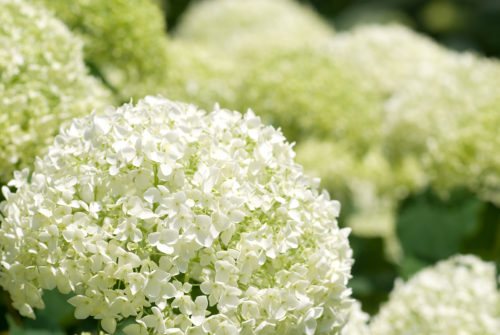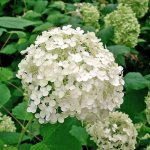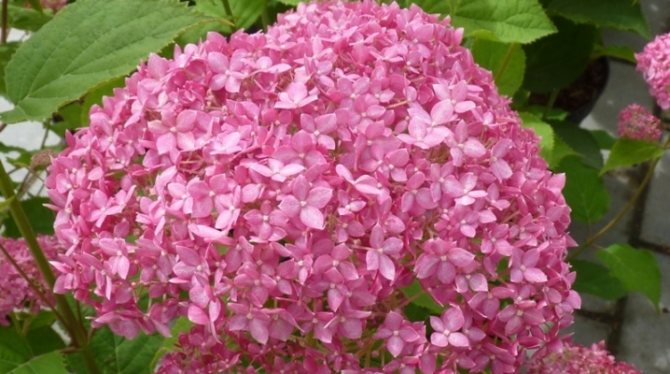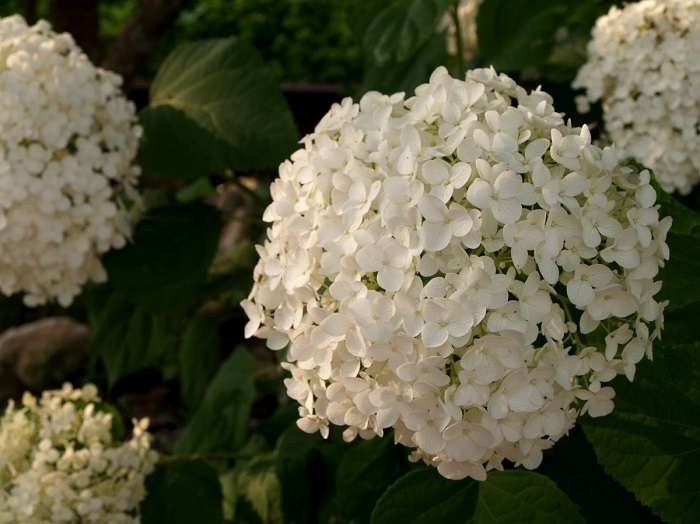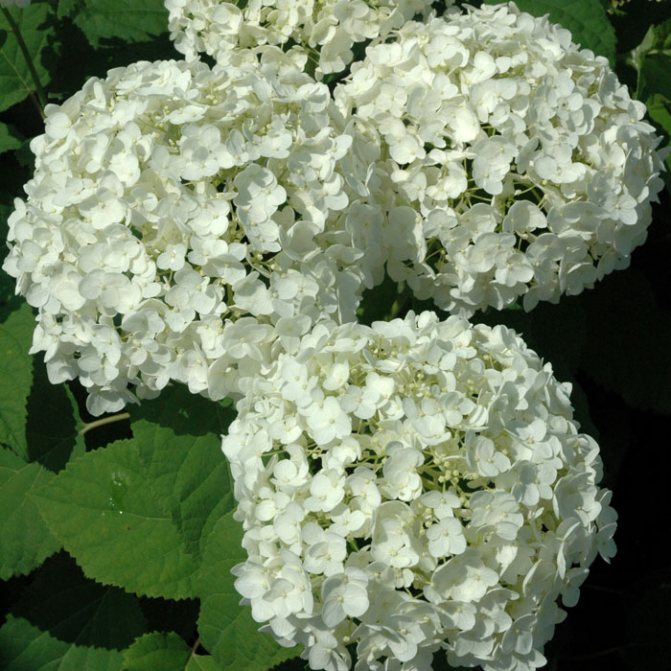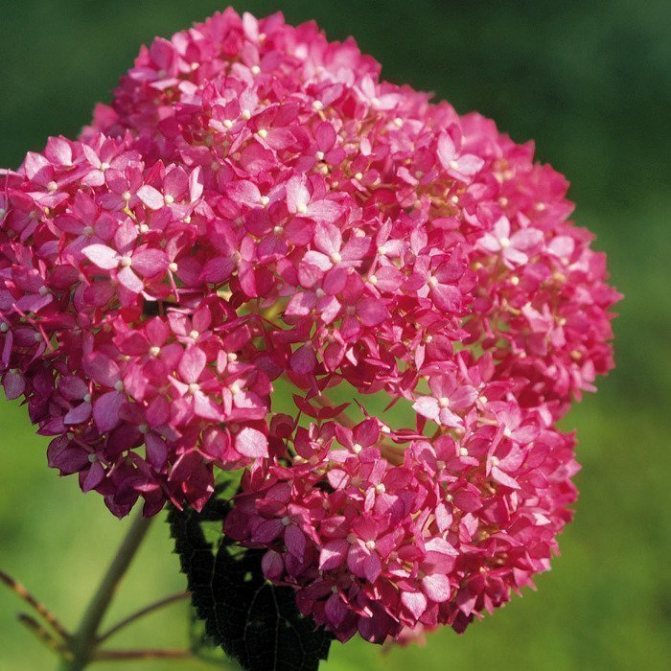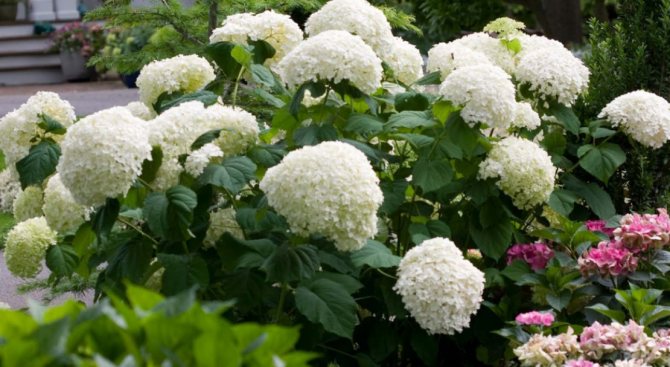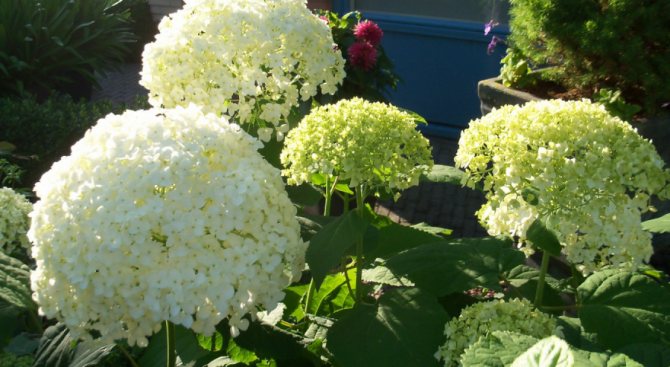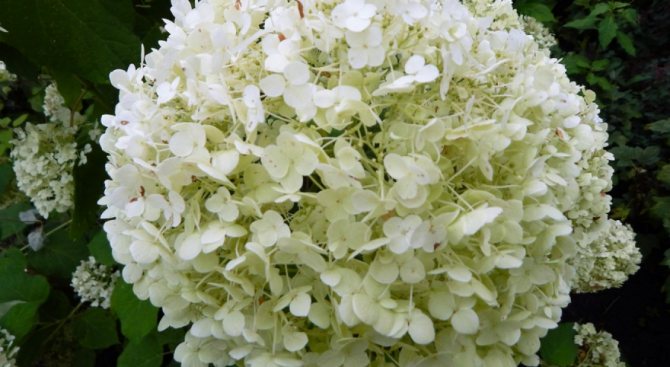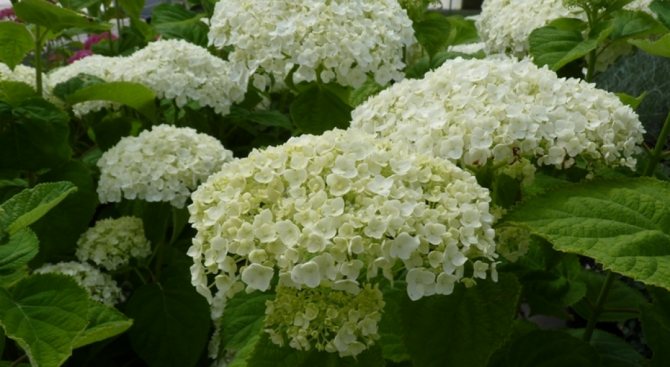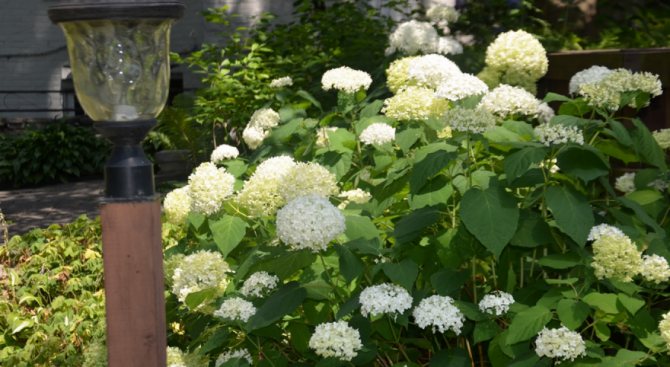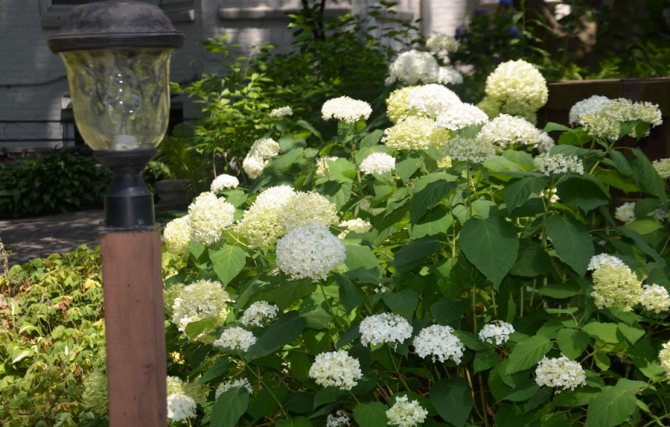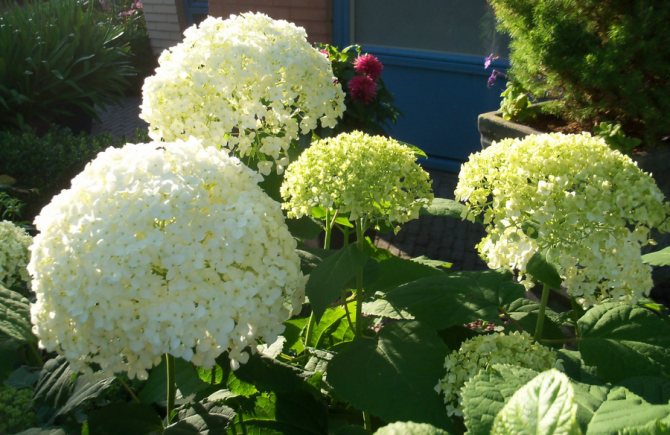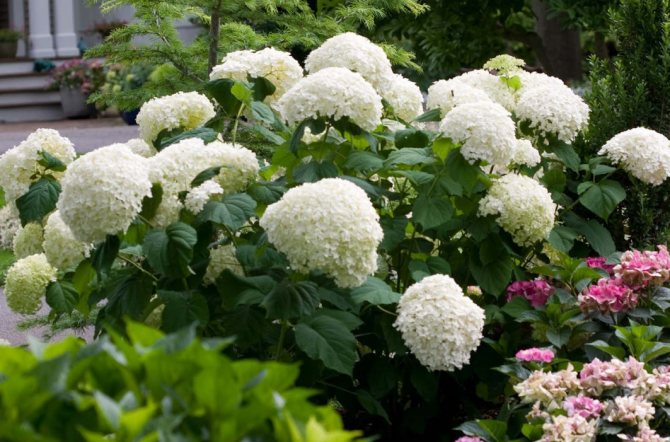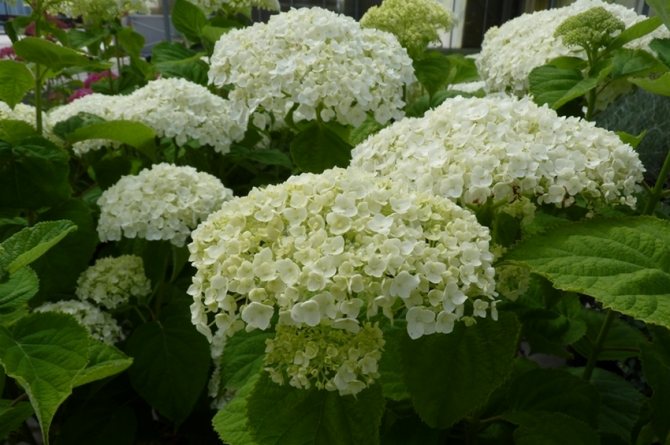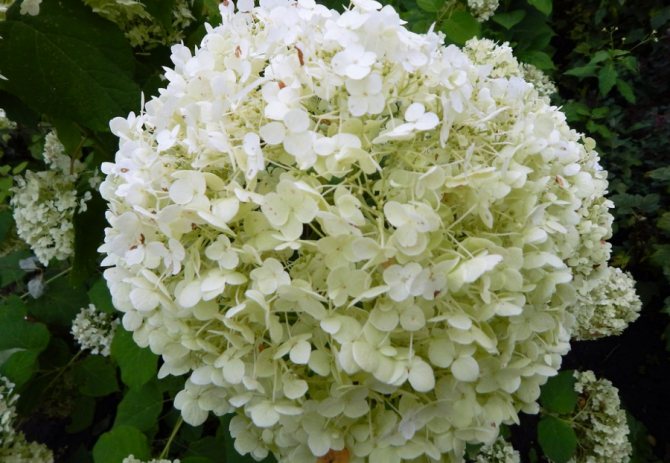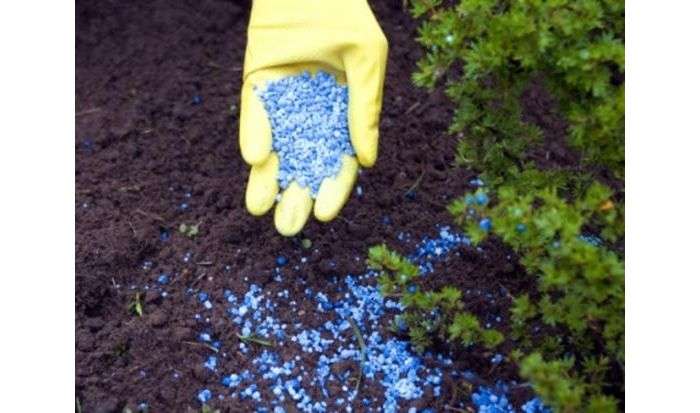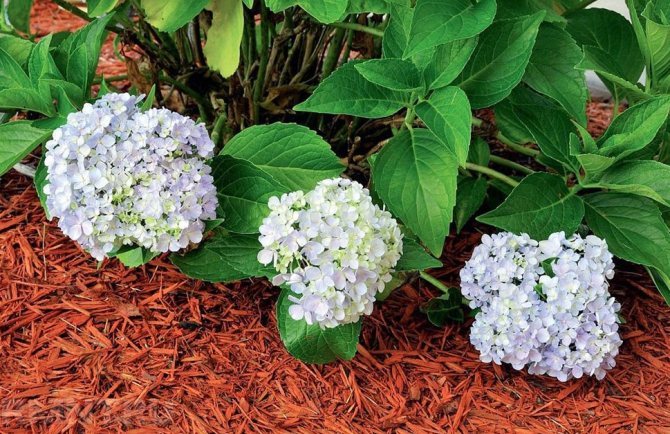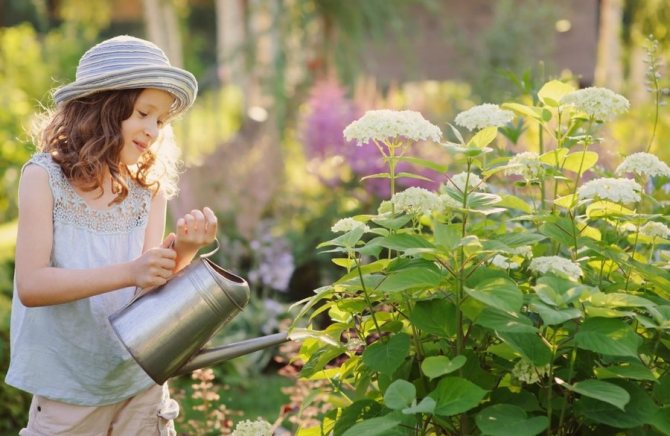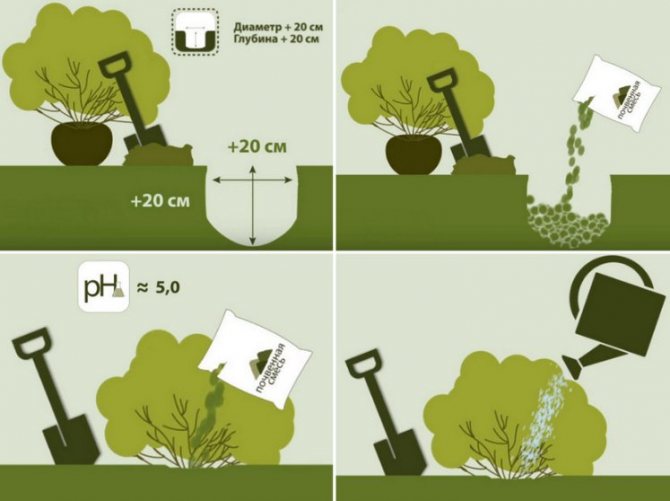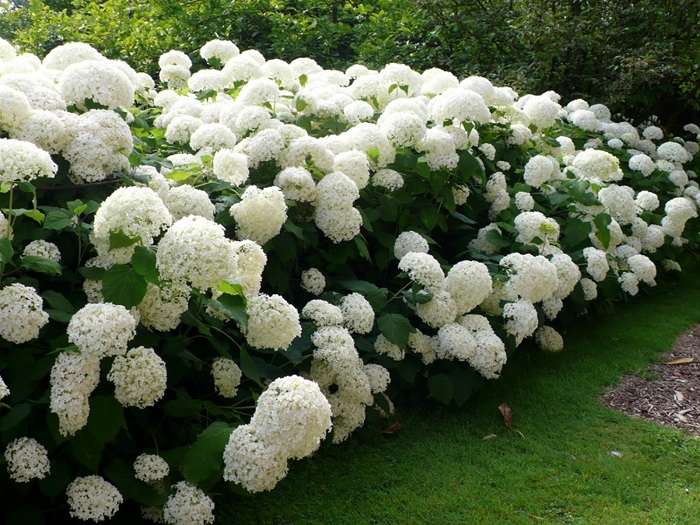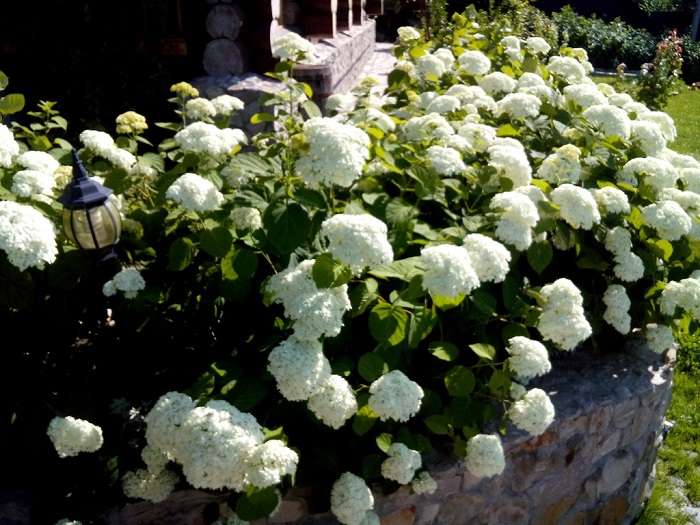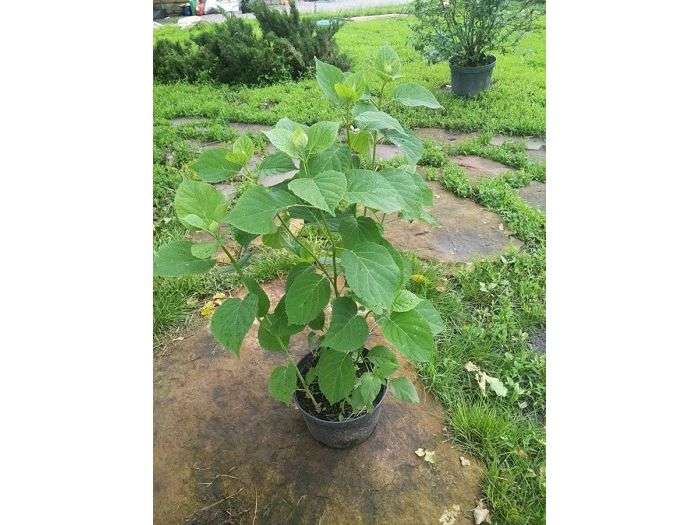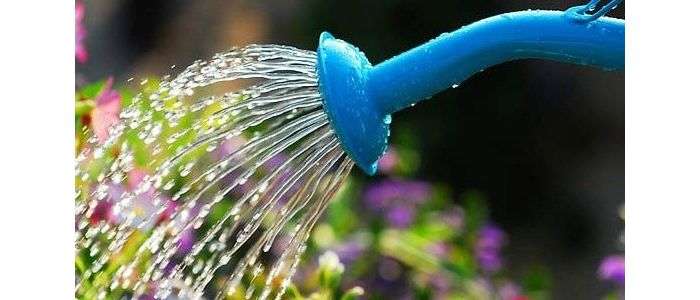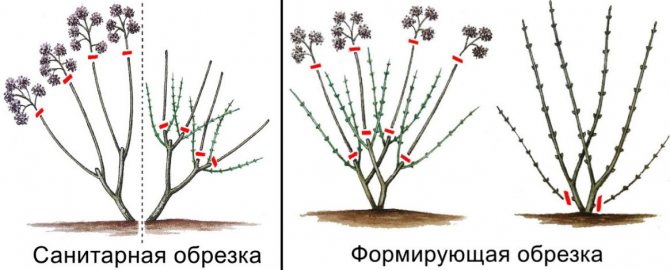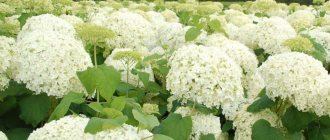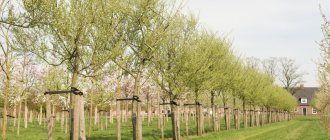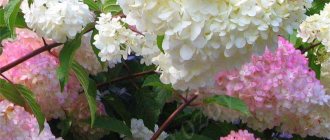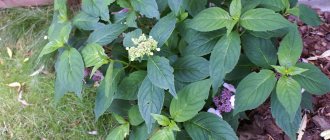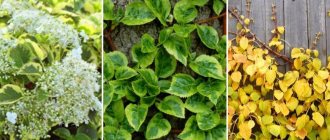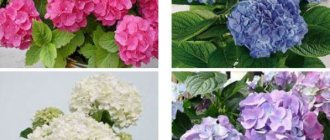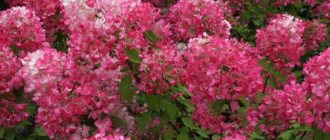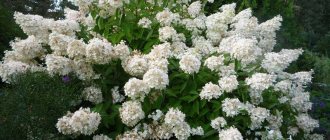Since the mid-70s of the last century, plants of this variety have been cultivated by the American nursery GulfStream. Once in Europe, the hydrangea with a wide spreading crown and numerous inflorescences-balls has become incredibly popular, and in the UK it has earned several prestigious awards from the Royal Horticultural Society.
Characteristic
On various continents, there are about 35 species of deciduous shrubs belonging to the genus of flowering plants of the hydrangea family. Hydrangea, or hydrangia (hudrangea) is translated from Latin as "a vessel with water." During the growing season, the shrub evaporates a lot of water and, if there is not enough water, it quickly withers.
In gardens, several types of hydrangea are usually displayed: paniculate, tree-like, large-leaved. Plants attract attention with large inflorescences in the form of a ball or panicle, green large leaves. Flowers in a bud are of 2 types: in the middle - small, fruiting, along the edges - large, sterile. The fruit of the hydrangea is a box with many small seeds.
Annabelle tree hydrangea is a beautiful shrub with a height of 1 to 2 meters. She has not very thick pubescent shoots. The leaves, attached to the branches with long petioles, are arranged oppositely. In mid-July, large inflorescences appear on the shoots.
The bush is up to 1.5 m high, the crown width is up to 3 m. Its leaves are rich green, oval, with a pointed end, retaining a bright color until frost. Hydrangea Anabel blooms in late June with white buds and stays like this until September. The inflorescence is dense, consisting of many small white flowers. Its length reaches 20-25 cm. This variety is not capricious, resistant to unfavorable climatic conditions, it can grow even in Siberia. In one place, the bush can grow up to 50 years without losing its decorative appearance.
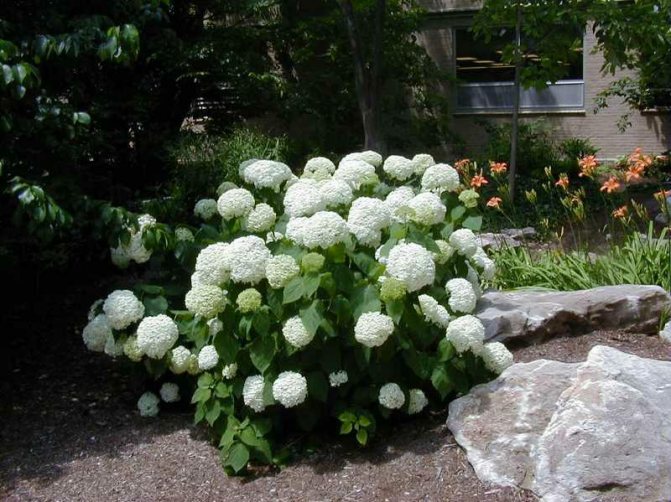
Hydrangea Annabelle (in the garden)
Note! This type of hydrangea can change the color of the inflorescences. To obtain a blue color, it is mulched with peat, spruce litter, and also fed with a solution of aluminum alum; for pink - apply large doses of phosphorus fertilizer.
Hydrangea Strong Annabel is one of the varieties of Annabel. The height is the same, but the flowering is much more abundant: at this time, foliage is almost invisible under the balls. The variety tolerates frost well, is resistant to diseases.
Hydrangea Pink Annabelle has pink flower caps. Initially dark pink, over time the color changes to a lighter color. The shoots of the bush are powerful, strong, do not bend to the ground even during the period of abundant flowering. The compact shape of the bush is maintained throughout the season.
Diseases
Despite the fact that this hydrangea variety is quite resistant to diseases and pests, there are some unpleasant moments that can occur during the growing process. Therefore, it will be useful to take preventive measures in time in order to avoid serious consequences. For these purposes, a weak solution of potassium permanganate is perfect. It pours profusely under the bush.
Among the most common diseases are chlorosis and powdery mildew. Chlorosis manifests itself as yellowing of the leaves with still dark veins and, if untreated, can lead to the death of the flower. Powdery mildew is characterized by yellow spots that turn brown over time. In advanced cases, the leaves begin to wither and fall off. In this situation, it is best to use chemicals. Folk remedies in the form of, for example, wood ash will not interfere.
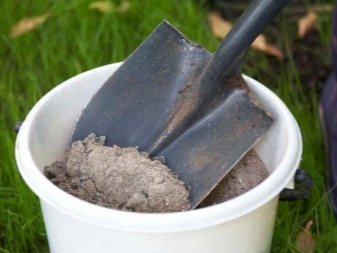

As for insects, spider mites attack the hydrangea most often. It is easily recognized by the presence of a thin web entangling the leaves. If the pest was noticed immediately, you can treat the bush with a solution of laundry soap.
In more severe cases, the formulations "Fitoverm" or "Vermitic" will help.
A brief description of the variety in the next video.
In our cool and unstable climate, of all types of hydrangeas, tree-like ones take root best. Such a variety of hydrangeas as Pink Annabelle is very popular. The plant has an unpretentious disposition and magnificent, lush flowering. Let's get to know this plant better, learn how to grow Pink Annabelle and how to care for it.
Description
The tree-like hydrangea Pink Annabelle is the sister of the popular Annabelle variety. But if Annabelle has snow-white caps of flowers, then Pink's, respectively, are pink. Note that the Annabelle variety is one of the oldest and most respectable varieties of hydrangea tree. It was bred back in the 18th century in the United States, and after a few decades, the plant spread to all the gardens of the world.
Appearance


The shrub reaches a height of one and a half meters, grows quite sprawling, powerful. Its shoots are powerful and strong, therefore, even during the period of the most active flowering, the branches do not bend to the ground. Thus, the shape of the bush is preserved: neat and compact.
The foliage of Pink Annabelle has a serrated shape characteristic of hydrangea, the leaves themselves are oval, turn yellow by autumn. In summer, the leaves are a bright green shade with a glossy sheen, but closer to autumn they fade, turn yellow, and then completely fall off.
The flowers are pink, collected in huge, lush inflorescences, shaped like a ball. The diameter of such an inflorescence-ball can reach 30-40 cm. The color of the flowers of the plant is not quite common. The fact is that Pink Annabelle is capable of changing color: if at first the flowers have a dark pink color, then as they bloom they become lighter and brighter.
Functional features
Flowers are formed only on young shoots, so the shrub needs complete pruning every year. The stronger the hydrangea is cut in autumn, the more magnificent and active it will bloom in the next season. The decorative period usually lasts from June to September. The best results are shown by shrubs on moist, fertile, loose and slightly acidic soils.
The flowering period of the plant is long - from the beginning of June to the end of August, you can enjoy the magnificent view of the lush bush. The plant is cold resistant and well adapted to the harsh Russian climate. The shrub is able to withstand frosts down to -40 degrees. However, young plants are not so hardy - the bar is set for them at -20 degrees, not lower.
Landing
Planting and caring for Anabelle hydrangea is easy. The plant prefers to grow on fertile, loose, well-moisturized soils. It is planted in partial shade or in sunny areas. These places must be protected from northerly winds. The root system of the hydrangea is pre-soaked for a short time in a weak solution of potassium permanganate.
Hydrangea Fries Melba - description, planting and care
If several plants are planted, for example, Annabelle and Strong Annabelle hydrangea, the distance between them should be 1.5-2 m.The planting hole is dug up to 50 cm deep.Humus and complex fertilizer are added to it. Plants are planted in the prepared hole so that the root collar is not buried.
Important! It is not recommended to add dolomite flour, lime, chalk, since these substances have an alkaline reaction, and hydrangea prefers an acidic one.
After planting, the earth is watered and compacted. The trunk circle is mulched with leaf humus, peat, sawdust. When growing a plant in regions with a more severe climate, for example, in the Urals, after planting, a canopy is made of shields.
The right choice of seedlings
When purchasing pink hydrangea seedlings in specialized gardening stores, pay attention to the appearance of the plant. There are 2 main types of sprouts on sale: with closed and open roots.
Please note that the seedling takes root well, at least 3 lateral processes and 5-6 buds must be formed on it. Make sure that the sprouts are safe and sound, the bark is not peeled off.
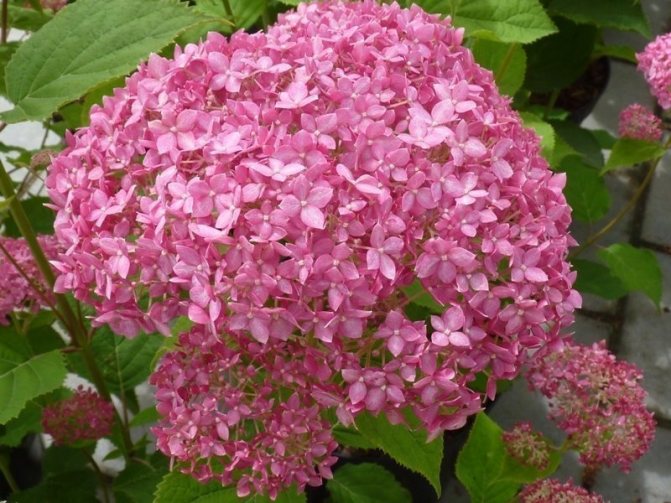

Be sure to find out when the Anabelle hydrangea shoots were planted in the container. Seedlings that were transferred to a separate container less than 14 days ago may not take root when transplanted into open ground.
It is important that plants with an open root system are healthy. Remember that traces of rot indicate a disease of the seedlings. Choose sprouts with a long root (at least 25-30 cm) for planting. The sprouts should be purchased directly on the day of planting. Better for planting in a garden area suitable 3-4-year-old shoots of Pink hydrangea.
Reproduction
Hydrangea Eternal Summer - variety description, planting and care
Perhaps in 4 ways: by seeds, cuttings, dividing the bush, layering. Let's consider each of them.
Seeds
Hydrangea seeds are small, so it is better to germinate them first. They are pre-soaked in a growth stimulant solution. Then cotton wool is laid out on a saucer, seeds are laid out on it, which are covered with another layer of cotton wool. A little boiled water is poured into a saucer so that the cotton wool is moistened, but does not float in the liquid.
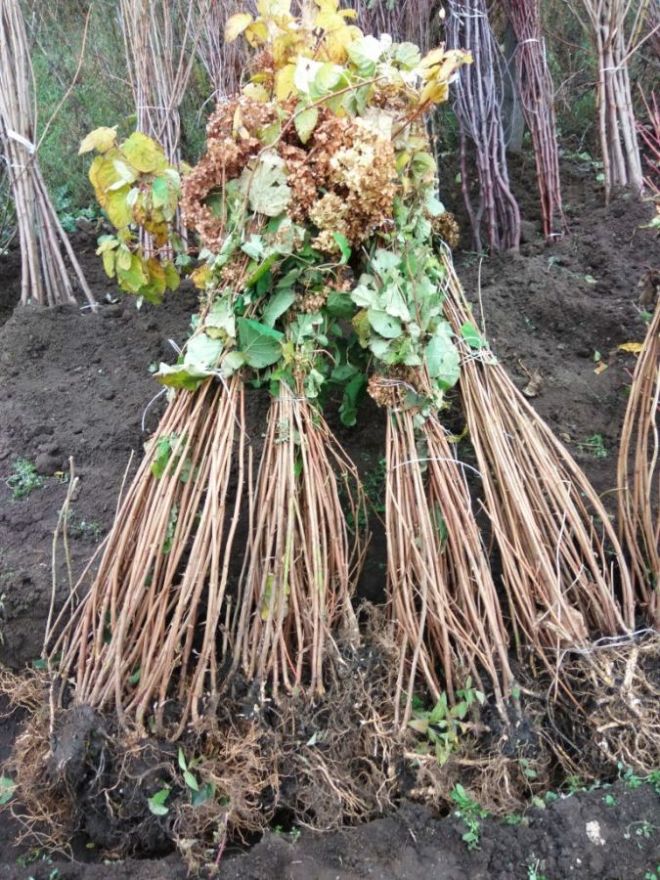

Hydrangea Anabel (preparation before planting)
After the seeds hatch, they are planted in a prepared soil mixture, consisting of peat, humus, sand, leafy earth, and are slightly covered with it. Seedling containers should be shallow, drainage pours out to the bottom. The grown seedlings are planted in the prepared place of the garden plot.
Also, seeds can be sown directly on the site in spring or autumn. In this case, they do not germinate, they are sown over the soil. It is not necessary to deepen: in the spring they are watered to contact the ground, and in the fall they will gradually deepen themselves.
Note! When sowing in spring, the seeds are stratified: within 1 month at t = 2-5 ° C. The procedure contributes to a more friendly germination of seeds.
By cuttings
This is one of the best methods for vegetative propagation. This method can be used to breed all types of hydrangia, including one of the most beautiful - the tree hydrangea Pink Anabel. Rooting is done with green cuttings under a film cover. Here's how to do it:
- cuttings are cut;
- the place of the lower cut is processed with a growth stimulant;
- a substrate of sand and peat is prepared;
- cuttings are planted to a depth of 3 cm with an interval of 5 cm in a row and 5 cm between rows;
- every day the greenhouse is ventilated, the seedlings are sprayed with water.
If the greenhouse is located in an open area, it must be shaded so that moisture does not evaporate from the leaves. This is done with burlap, shields, or other materials.
Note! After 15-20 days, the cuttings take root, the film with shading is removed. For the winter, the plants are covered with dry foliage, then covered with a film. In the spring, after thawing the soil, the plants are planted in a 15 × 15 pattern on a picking bed.There, the bushes are grown, then planted in a permanent place.
Propagation by cuttings can also be done indoors. To do this, cut cuttings are planted in pots with a substrate of peat and sand. Top covered with a plastic bottle with a cut-off bottom or film. Airing and moisturizing the plant is required. When the cutting takes root, it is planted in the garden in the spring.
By dividing the bush
This method is used in spring or early fall. This happens in the following sequence:
- the bush is undermined with a pitchfork;
- the plant is divided into parts: on each division there should be roots and shoots;
- each bush is planted in a prepared planting pit;
- the plants are watered, the planting circle is mulched with peat or sawdust.
On a note! There is another way to divide the bush, without digging it up. A small tunnel is made, several branches with roots are separated with a pruner. The separated parts are planted in a permanent place.
Layers
Rooting by layers is done in spring or autumn. The procedure is not laborious, and by the spring several young shoots with roots are formed, ready for transplantation. The rooting process by layering step by step:
- the soil around the bush is dug up and leveled;
- the branch chosen for rooting is laid horizontally to the ground and slightly pressed into it;
- in several places the shoot is pinned or pressed to the ground with pebbles;
- a small part of the top should remain above the soil surface;
- a little earth is poured on top of the shoots, which is then slightly moistened.
After 3 weeks, roots and young shoots will appear on the shoot. When they reach a length of 10 cm, it is necessary to huddle. Cuttings are separated and planted in a year, in spring or autumn.
Description
Our heroine is a species of a whole group of plants, which has the common name Annebelle. Other names of the flower: Hydrangia and Hydrangia Pink Anabel. This plant is characterized by rapid growth (during the season it increases in size by 20 cm), the strength of the tree-like light brown shoots that form the bush and prevent it from falling apart. The height of the hydrangea ranges from 90 to 120 cm. The width of the bush and the size of the rounded crown are about the same, sometimes reaching almost 3 meters. On the slightly pubescent shoots of Pink Annabelle, large oblong or ovoid leaves are formed with serrated edges and a sharp top, painted in a bright green color.
The fragrant flowers that emerge on young stems are simply delightful. Initially, they have a patchy dark pink hue. This effect is achieved due to the different intensity of color on the lower (dark pink) and upper (light pink) surface of the petals. When the flowers bloom completely, they take on a bright pink hue. They are regular in shape, consist of four petals and are collected in large, rounded, slightly flattened, rather dense inflorescences that stand out on the plant with lush caps. The diameter of each such inflorescence is about 30 cm. Pink Anabel flowers are sterile. Thanks to all these features, the culture is a very ornamental shrub. True, at the end of the flowering phase - abundant and lasting from the end of June to September - the inflorescences acquire a not very attractive gray tint.
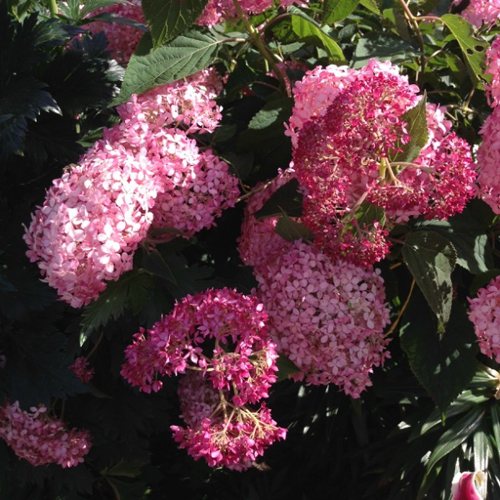

Interestingly, under the weight of impressive inflorescences, the treelike shoots of hydrangea do not break. They are generally very difficult to bend. Another important advantage of the variety is its high resistance to frost. But when cultivating crops in the northern regions, you will have to resort to covering materials in order to avoid the death of the plant.
Care
To properly care for a hydrangea, it must be watered abundantly, loosened, fed, cut off. The hydrangea will build up a lush green mass and bloom in beautiful lush buds.
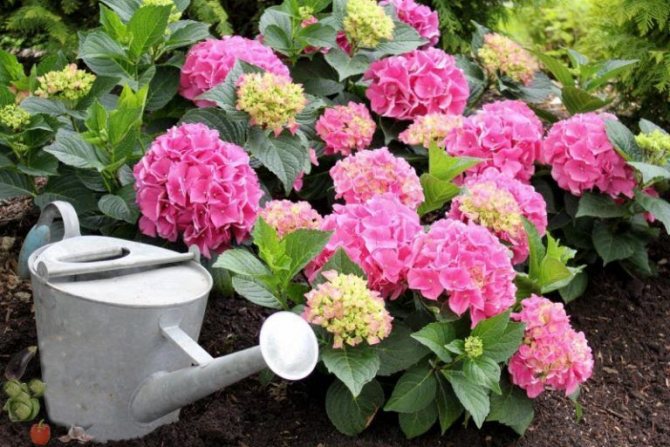

Watering hydrangea
Watering
Hydrangea Earley Sensation - variety description, planting and care
Hydrangea bushes are moisture-loving, so you need to water it often, at least 1 time a week. At least 2 buckets of water are poured under each bush. In dry summers, watering increases up to 2 times in 7 days. The water should be warm, heated under the rays of the sun. Periodically, you can add a little potassium permanganate to it to prevent rot. Watering is done in the morning or evening.
Loosening and mulching
The soil should be loose, free from weeds. When loosening, moisture will be retained, there will be air access to the roots. In hydrangea, the root system is located close to the soil surface, so loosening is done no deeper than 3-7 cm.
To protect the soil from overheating, preserve moisture, the soil is mulched. Peat, sawdust or a mixture of these materials are selected as mulch. Layer thickness - 3-5 cm.
Note! Mulching with peat and sawdust will make the soil more acidic, which will have a beneficial effect on the growth of hydrangeas.
Pruning
There are sanitary pruning and shaping. When sanitary, all broken, old, diseased shoots are cut out. Trimming in this case is done to the very base.
Formative pruning is done in the spring, before sap flow. This rule is common to all chrysanthemums, including the Pink Annabelle hydrangea. The procedure promotes better tillering. Cuttings can be used for propagation. If you leave one shoot and cut the rest, the hydrangea will form into a tree.
Pruning a bush
The tree hydrangea "Anabel" is cut in spring and autumn. Spring pruning is sanitary and formative. It is carried out before the onset of the growing season of the plant.
Sanitary pruning consists of removing all damaged shoots. Dried, frost-damaged and broken branches are completely cut out. It is also necessary to remove the shoots that thicken the crown. The branches growing inside the bush must be cut out, as they will interfere with the growth and flowering of the Anabel hydrangea.
Usually, sanitary pruning is combined with a shaping... To maintain the decorative effect of the crown, long shoots are shortened to give the bush the desired shape. The shortening of the branches stimulates the development of lateral shoots and abundant flowering in the future. And to make the bush look beautiful and neat, the shoots that appear near the trunk are also cut out.
In the fall, during the preparation of the plant for the winter period, pruning is also carried out after flowering. In this case, all dried inflorescences are removed. Together with them, 2-3 uppermost kidneys are removed.
Possible diseases and pests
Although hydrangea is a fairly disease-resistant plant, some of them are sometimes affected.
- Floury dew... It is caused by soil-borne fungi. All affected parts are removed, the bush is treated with a solution of any fungicide.
- Gray rot... Fungal disease primarily affecting young cuttings. The treatment is similar: the affected shoots are cut out, the remaining ones are sprayed with a fungicide solution.
- Annular spotting... Refers to viral diseases. Possible causes of the disease are infected planting material, the use of poorly processed tools, and various insects can also infect. The disease cannot be treated: the bush is destroyed.
- Chlorosis... The disease is characterized by yellowing of the leaves. In this case, the lack of iron affects. As a treatment, feeding with iron preparations is performed.
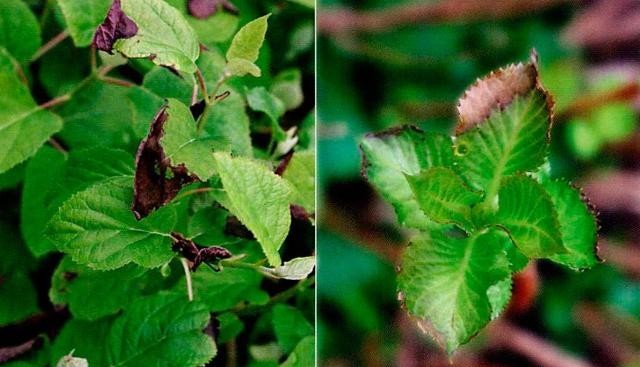

Chlorosis city license
Hydrangea can also be attacked by various insects and pests. Timely detection of them and the measures taken to combat them will save the bushes from death.
- Leaf aphid. It is very dangerous, because it can drink juice from leaves and stems in a short time. Ladybugs can handle it.If there are too many aphids, the plant is sprayed with insecticidal preparations.
- Spider mite. He easily discovers himself by the fact that in his habitat the branches will be braided with cobwebs. Control measures are the same: spraying with insecticides.
- Slugs. They plant in damp places, eat up foliage and stems. They are harvested by hand or a molluscicide is bred, which is scattered around the habitats of slugs.
Using hydrangea in garden design
Hydrangea in the garden is planted both singly and in an ensemble with other plants. In landscape design, the use of hydrangea is very diverse. It is very popular with garden architects of the Moscow region.
One of the options is that it can be planted in the coastal area, where it will become the main decorative element. Hosts, incense, astilbe, and other moisture-loving flowers will look good nearby. Even when the hydrangea fades, the composition will look beautiful due to the variety of leaf plates.
On a note! Hydrangeas Anabel and paniculata, for example, Limelight, look spectacular next to conifers, decorative deciduous shrubs. Hydrangea can be a background for low-growing plants, or vice versa, set off taller ones. If there are unsightly buildings on the site, the hydrangea will decorate them beautifully.
Hydrangea can grow in one place for many years. Given this fact, the gardener can change the look of his site annually, planting other plants to it each time. And vice versa, by planting beautiful perennial shrubs next to the hydrangea, the gardener will keep his garden in a consistently decorative, unchanging state.
Hydrangea tree Anabel, planting and care
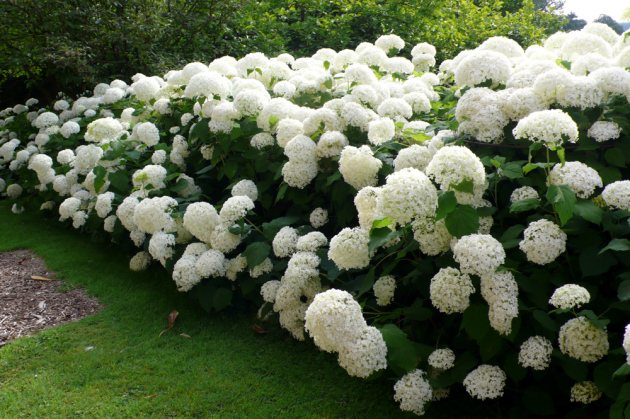

A lushly blooming garden is not just a source of pride, but also a delight for the soul of any gardener. Sometimes it is difficult to please some flowers and plants so that they can fully show their beauty. But among them, one very unusual tree-like hydrangea called Anabel stands out. It is flawless in every sense: it has large pretty inflorescences, it easily takes root in any soil, it tolerates pruning well, is completely frost-resistant and is considered the most unpretentious beauty of the garden.
Hydrangea tree Anabel - varietal features
Annabel, or Hydrangéa arboréscens, is considered one of the oldest but still popular varieties of hydrangea. Anabel was discovered in the middle of the 18th century, more precisely in 1746 in the province of Anna, located in Ohio (USA). After a couple of decades, this treelike hydrangea "scattered" all over the world.
- Anabel is a fast growing deciduous shrub. During the year, its domed crown grows 12-15 cm in height. The leaves are oval in shape with jagged edges, in summer the leaves are bright, light green, with shine. Closer to autumn, their color fades, yellowness appears, and before the arrival of winter, the foliage falls off.
- Hydrangea tree-like Anabel is winter hardiness. Its frost-resistant threshold is -40⁰С. But young shoots can freeze out at -20⁰С.
- The plant grows successfully in partial shade, but active flowering occurs only in an open sunny area. Anabel can tolerate drought patiently, but it is best to provide moderate watering to protect the foliage from wilting. Hydrangea loves open space, as its crown often reaches 2.5-3 m in diameter. But when choosing a place for planting, you need to take into account that it does not tolerate drafts well.
- Anabelle hydrangea planted in the garden looks spectacular and romantic at the same time. Its aroma is light and pleasant.Despite its delicate appearance, this hydrangea does not require painstaking care, hibernates well even at the lowest temperatures and is remarkably resistant to disease. It is capable of blooming annually without the introduction of multicomponent fertilizers, and retains its decorative effect for up to 50 years in one place without transplanting.
- Hydrangea Annabel is distributed in the wild throughout Japan, North America and China. In nature, it rarely grows above 3 m in height and is densely covered with medium-sized thyroid inflorescences, consisting of small flowers.
- In culture, Anabel is found everywhere and easily gets used to any climate and is well cultivated. Since it regularly undergoes pruning, the cultivated shrubs rise 1.5-2 m above the ground and are covered with larger inflorescences up to 20 cm in diameter.
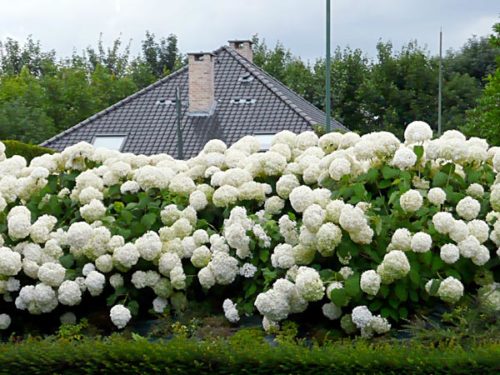

Varieties of tree hydrangea Anabel
Annabelle in bloom is admirable. Flowering occurs from July to October. The color largely depends not only on the variety of hydrangea, but also on the soil in which it grows. The most common hydrangea, Anabel, blooms with white multi-flowered umbrellas. They can be snow-white, with light green or pale pink base of the petals.
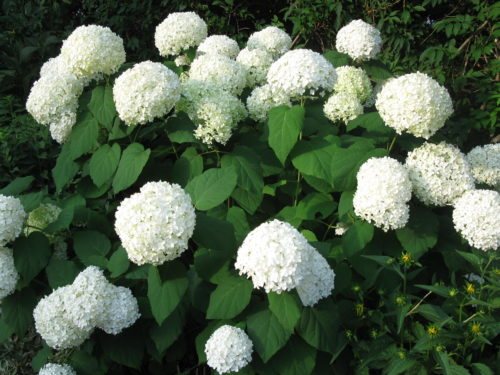

Pink flowering occurs in one of the tree hydrangea variations - Pink Anabel. Outwardly, the plant does not differ from the snow-white beauty in nothing, except for color. Pink Annabel prefers alkaline soil, abundant watering and a sunny area. It blooms with the arrival of summer and retains its inflorescences until late autumn.
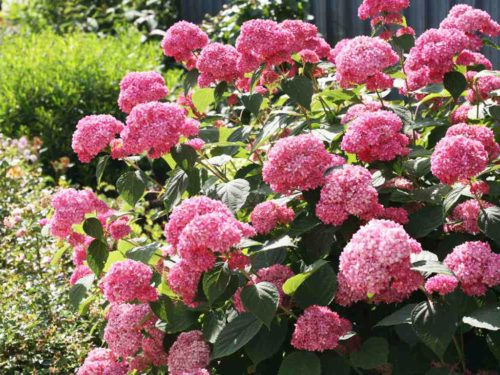

The most beloved hydrangea by gardeners with huge white inflorescences, under which almost all the foliage is hidden, is Strong Anabel. She is perhaps the most luxurious member of this family. In care, the Strong Anabel hydrangea tree is also not capricious, and requires only regular pruning and minimal fertilization so that the buds do not shrink.


Hydrangea tree Anabel - planting
Treelike hydrangea seedlings are planted in early spring or early autumn, respectively, they need to be planted in May or September. Planting in spring is carried out at the stage of budding, when flowering has not yet begun and the buds are dense and not fully formed. In the fall, during planting, it is important to prune the remaining inflorescences so that the hydrangea can take root safely.
Which plot to choose for hydrangea tree-like Anabel
If you choose in advance a suitable place for a hydrangea, you can forget about transplanting it for many years and just enjoy its beauty and aroma. First of all, you need to exclude the presence of strong winds in the selected area. Make sure there is a shelter nearby that will obstruct drafts. Ornamental trees, a high fence or wall will cope with this role.
The solar factor is equally important. Annabelle does not like the scorching sun, but she should be well lit most of the day. Moderate partial shade in the morning is ideal.
Hydrangea is a moisture-loving shrub. It is necessary to limit the presence of trees with a large root system near it and regularly moisten the soil during the hot season. If the soil is constantly dry, there is a high probability that the buds will not appear this season.
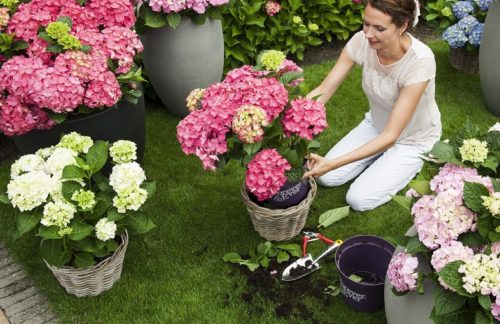

Preparing the soil for hydrangea tree-like Anabel
Hydrangeas do not survive transplanting well, so the preparation of the soil must be conscientious. Active budding and rapid growth of hydrangea is provided by a drained and nutritious soil with a neutral or acidic pH. It is preferable to plant the bush in loam - a ball of loose clay soil with very fine particles and an admixture of sand. Such a substrate is laid out in the planting pit 7-8 days before the intended planting, so that it is completely saturated with oxygen and cakes.Additionally, fertilizers need to be applied to the bottom of the pit: phosphorus for white and pink hydrangeas, potassium for blue and purple inflorescences.
Please note: you do not need to add lime and ash to the soil before planting. This will impair the rooting and flowering of the hydrangea.
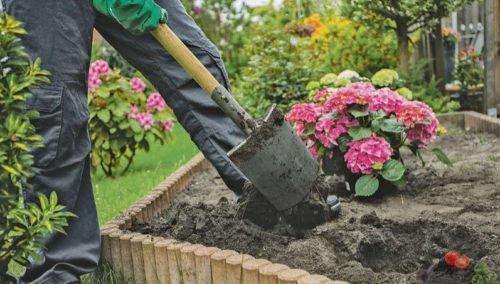

Stages of planting a bush of hydrangea tree-like Anabel in the ground
Hydrangea tree Anabel, according to gardeners, is easily planted and quickly takes root in a new place. There are no special secrets, just a regular planting is carried out in compliance with the nonspecific rules of agricultural technology.
Planting hydrangea Anabel in the ground takes place in the following sequence:
- The root system of a young seedling must be disinfected. A weak solution of potassium permanganate is suitable for this.
- The planting pit should be wide with a depth of 50-55 cm. Fertilizers and a layer of suitable soil mixture are applied to the bottom (this was already mentioned a little above).
- Then the root system is immersed in a hole up to the root collar and covered with a loose substrate and compacted a little.
- At the end, the hydrangea is watered abundantly in a circle, while trying not to pour water on the roots.
- If the planting takes place on a hot day, the aboveground part of the hydrangea is shaded, if on a cold day, a greenhouse shed is placed.
The planted hydrangea Anabel blooms only for 3-4 years.
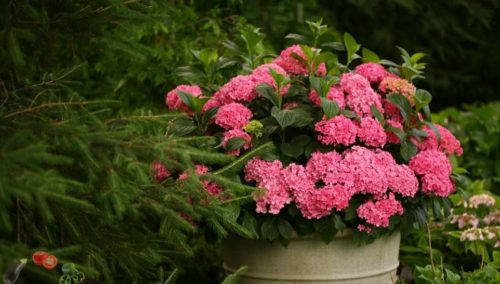

Anabel hydrangea tree - care in the garden
After planting, it is important to keep the soil moist by mulching. The mulch will also keep weeds from overgrowing and act as a barrier that protects the root system from overheating. Mulching material (wood chips, tree bark, peat) is laid out with an 8 cm ball in the trunk circle.
Watering a still fragile seedling should be frequent and abundant. Until the aboveground part grows up enough, you need to protect it from pests. Use a manganese solution, various insecticides, Bordeaux liquid.
Mulching should be carried out at the end of spring, when the soil is still wet, but it has already warmed up sufficiently with heat. Over time, the mulch will rot and make an excellent fertilizing substrate with a suitable acidity level.
To provide suitable conditions for the growth and flowering of the Anabel hydrangea, you need to fertilize the soil during planting, at the end of May and in the first days of July. As a fertilizer, you can use diluted mullein or chicken manure in a ratio of 1:10 with water. Additionally, mineral fertilizers are introduced - superphosphate, potassium nitrate, urea (2: 1: 1). You can regularly water the bush with fertilizer for hydrangea with a high content of iron and magnesium.
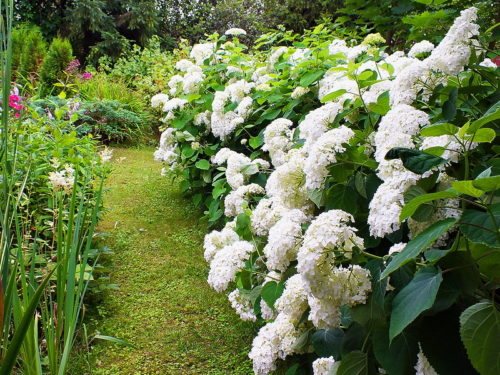

Hydrangea tree Anabel - pruning and wintering
A good time to prune hydrangeas is late fall. Cutting of inflorescences, old or damaged shoots is carried out. Sanitary pruning can also be done in early spring before the leaves appear. You need to choose the strongest stems that have bloomed, and shorten them to 5 cm, the rest of the shoots must be completely cut off. This will enhance future flowering, strengthen the stems.
All types of treelike hydrangeas are winter-hardy, including Anabel. No special preparations for winter are required. You need to carefully bend the stems to the ground, try to pin them so that they are not damaged, and then cover them with a low layer of fallen leaves. After the end of frost, the shelter is removed.
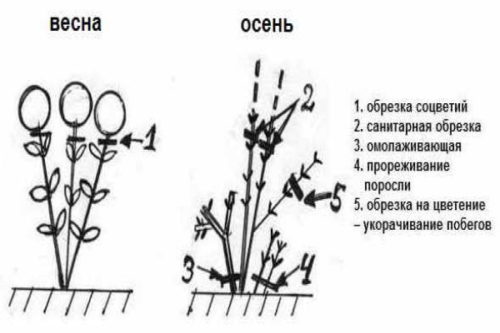

How to propagate Anabelle hydrangea tree
The easiest and most effective way to propagate Anabel hydrangea is by cuttings. In the fall, during pruning, several cuttings 15 cm long are selected. You need to pay attention to the fact that shoots that have not bloomed take root better. Then the slices are kept in any preparation that stimulates root growth, and then planted in the ground. With the help of a cut PET bottle, a greenhouse structure is created. It needs to be opened periodically to enrich the earth with oxygen.
Before the onset of cold weather, young shoots should be covered with agrofibre. If they grow in climates with harsh winters, it is best to transplant them into a pot and put them in a home or cellar. In May, they are planted back into open ground.
Treelike hydrangea can be propagated in another way - arcuate layering. In September, a shallow ditch is dug near the bush. Then a healthy one-year shoot is selected and a shallow cut is made on it. The shoot is laid in a ditch, cut down and fixed in this position with a wire. At the end, the ditch is covered with earth, watered abundantly and sprinkled with mulch material. In the second year, the cuttings are separated from the mother bush and transplanted to a suitable site.
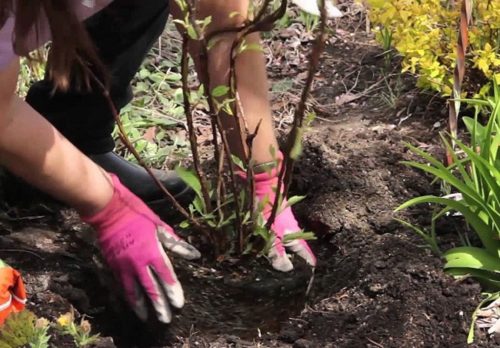

What diseases and pests can infect the hydrangea tree-like Anabel
Hydrangeas rarely get sick. If this happens, then most often the spider mite becomes the culprit of the disease. This invisible pest settles on foliage for a long time and begins to suck out all the juices from the plant. You can understand that the bush is sick by yellowing and falling leaves. If the hydrangea is not treated with acaricides in time, it may die.
Powdery mildew may occasionally appear. After infection, yellow-brown spots appear on the leaves. Over time, the foliage falls off, and the plant dies. This fungal disease can be successfully treated by spraying with a copper solution.
If a hydrangea is planted in alkaline soil, it is prone to developing chlorosis. The plant takes on an unsightly appearance: the leaves brighten, as if they burn out in the sun, flowering disappears. Fertilization with the maximum concentration of iron helps to get rid of the disease.
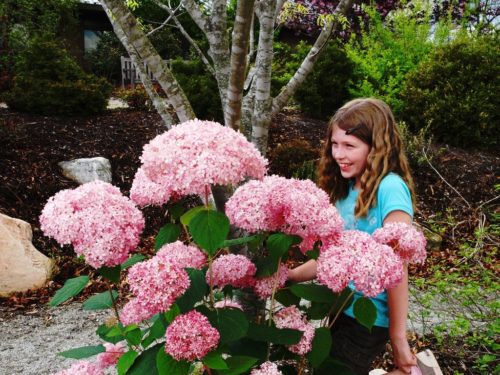

Changing the color of the petals of Anabel hydrangea tree with a photo
Anabel is a unique representative of the Hortensiev family. The mystery of this species lies in the exceptional property of changing the color of the petals. This happens at the request of the gardener, who, with the help of certain substances, changes the pH of the soil, which causes a change in white to blue, scarlet or purple. Experienced gardeners can even achieve that the same bush will bloom differently all the time.
This feature of Anabel lies in its ability to actively absorb coloring elements and some chemicals that affect the pigments in the petals. If you dream of growing a pale blue hydrangea, you need to choose a tree-like hydrangea of the Anabel variety of white color and acidify the soil by adding preparations with aluminum.
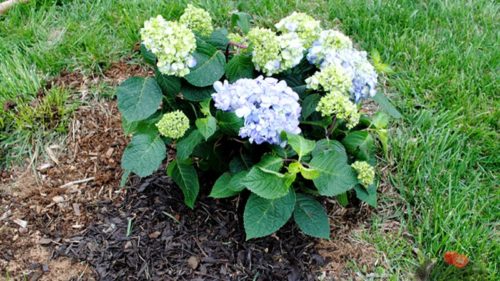

The soil should be watered with an acidic solution until the pH level reaches 5.5, but not higher. During the transformation of the color of the petals, it is important to completely exclude the introduction of phosphorus-containing fertilizers. It is better to conduct such an experiment on an adult hydrangea, since young seedlings may die.
The effect will not be instantaneous, so you have to wait. Some gardeners manage to change color in one season, while others take a couple of years.
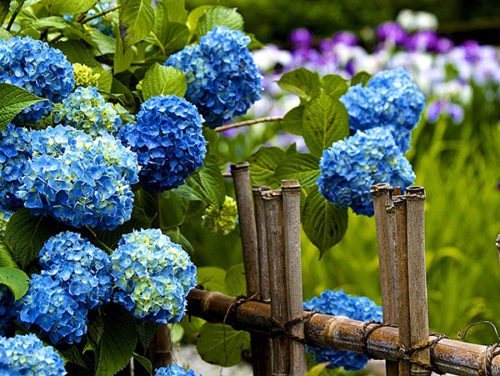

If you have a white hydrangea and want a deep pink color, you need to bring the soil to a neutral pH. This will require dolomite flour, lime or phosphate fertilizers. But in this matter, the main thing is not to overdo it - an excess of chalk and phosphorus can completely destroy the hydrangea.
Select fertilizers with a high content of phosphorus and nitrogen, and always without potassium. Alternatively, you can buy a seedling of a hydrangea tree-like Pink Anabel in a store, and then maintain the required pH level of the soil. This will be much more convenient, because you do not have to wait long for the plant to change color on its own.
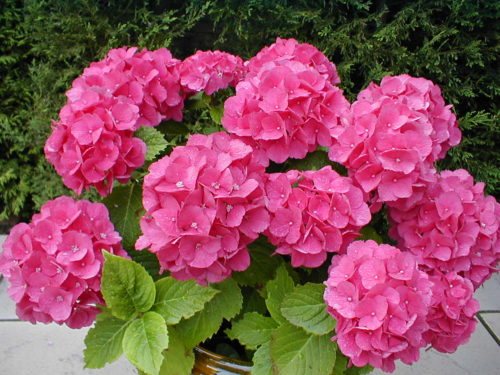

Historical fact! Archaeologists around the world find fossilized remains of hydrangea, which are approximately 55-70 thousand years old.
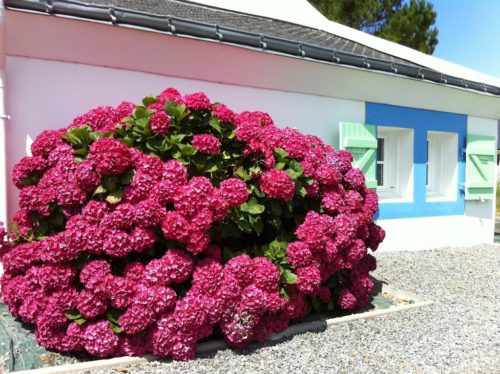

Hydrangea Annabel is a great addition to landscape design. It can grow alone, growing up to 2-3 m wide, or get along well with other "inhabitants" of the garden.Having planted this beauty on your site, you can admire its delicate flowering for a whole season without making any special efforts.
